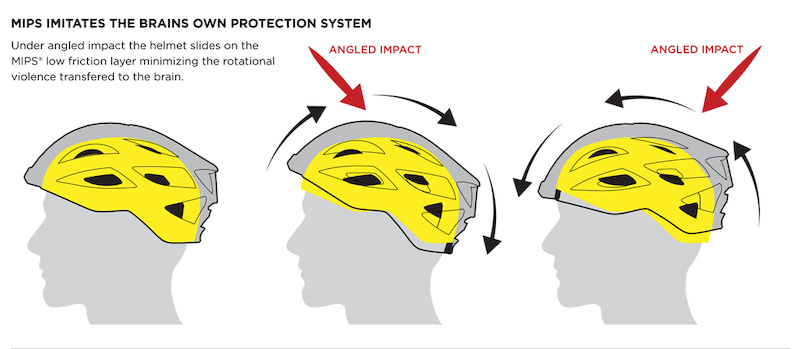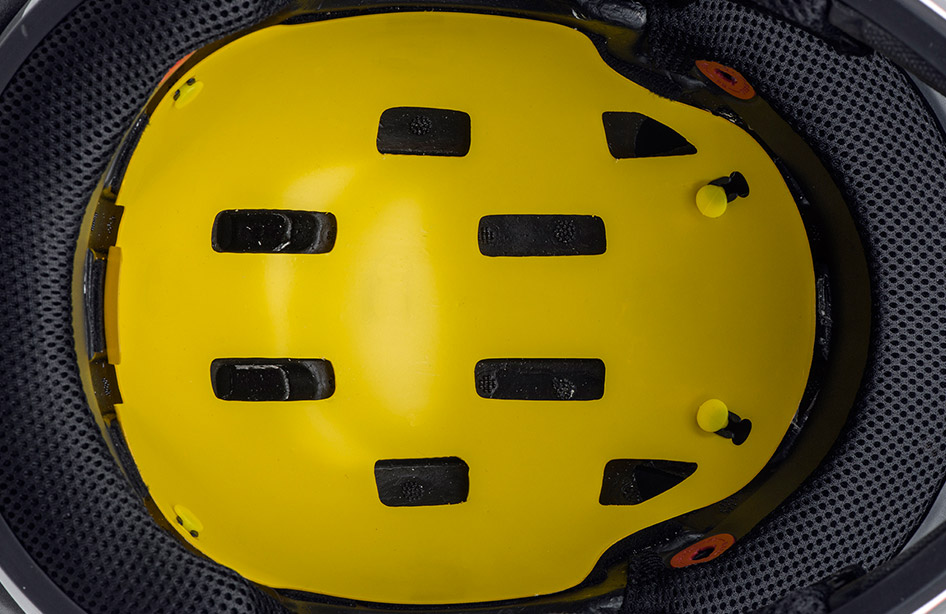MIPS: A Cutting-Edge Safety Feature in Cycling Helmets
MIPS, or Multi-Directional Impact Protection System, is a state-of-the-art technology designed to enhance safety in cycling helmets. This innovative feature has gained significant attention in the cycling community due to its potential to reduce the risk of brain injury during certain impacts. The primary function of MIPS is to minimize rotational forces on the brain, which can occur when the head experiences angled or oblique impacts.
How Does MIPS Work in Helmets?
MIPS, or Multi-Directional Impact Protection System, functions by incorporating a low-friction layer inside the helmet. This layer allows the helmet to slide relative to the head during angled impacts, thereby reducing rotational forces on the brain. These forces can result from oblique or angled impacts, which are common in cycling accidents.
The MIPS technology is designed to mimic the brain’s own protective system, which allows it to move slightly within the skull to reduce the risk of injury. By integrating this functionality into a helmet, MIPS offers enhanced protection against rotational forces, which are often associated with concussions and other traumatic brain injuries.
Numerous scientific studies and research have supported the effectiveness of MIPS technology. These studies have demonstrated that MIPS-equipped helmets can reduce the risk of concussions and other head injuries during angled impacts, making them an attractive option for cyclists concerned about safety.
MIPS-Equipped Helmets: A Comparative Analysis
MIPS-equipped helmets offer advanced safety features compared to traditional helmets, thanks to the integration of the Multi-Directional Impact Protection System. This technology has gained traction in the cycling helmet industry due to its potential to reduce rotational forces on the brain during certain impacts.
When comparing MIPS-equipped helmets with traditional helmets, there are several key differences to consider. MIPS-equipped helmets typically have a slightly higher price point due to the additional technology and manufacturing processes required. However, the enhanced safety features and potential for reduced head injuries may justify the extra cost for many cyclists.
Some popular MIPS helmet brands and models include the Giro Synthe MIPS, the Smith Forefront 2 MIPS, and the POC Octal AVIP MIPS. These helmets have garnered positive reviews from cyclists for their comfort, ventilation, and safety performance.
While MIPS-equipped helmets offer additional protection, it is essential to remember that traditional helmets still provide essential safety features. Both types of helmets must meet the same safety certifications and regulations, ensuring a minimum level of protection for all cyclists. Ultimately, the choice between a MIPS-equipped helmet and a traditional helmet depends on individual preferences, budget, and safety considerations.
Selecting the Right MIPS Helmet for Your Needs
When purchasing a MIPS helmet, there are several factors to consider to ensure the best fit, comfort, and protection. First, evaluate your specific needs as a cyclist, such as the type of cycling you engage in, your budget, and your personal preferences.
Fit is crucial when selecting a MIPS helmet. A properly fitting helmet should sit level on your head, covering the top of your forehead without obstructing your vision. The helmet’s straps should be adjusted to form a “V” shape around your ears, and the chinstrap should be snug but comfortable, allowing only one or two fingers to fit between the strap and your chin.
Comfort is another essential factor when choosing a MIPS helmet. Look for helmets with adequate ventilation to keep your head cool during long rides. Padding and interior materials should also be considered, as they can impact the helmet’s overall comfort and fit.
Price is a significant consideration for many cyclists. MIPS-equipped helmets typically have a higher price point than traditional helmets due to the additional technology and manufacturing processes required. However, there are various MIPS helmet options available at different price points, ensuring that cyclists can find a helmet that fits their budget and safety needs.
Lastly, ensure that the helmet you choose meets the appropriate safety certifications and regulations. While MIPS is not a certification itself, it complements existing safety certifications such as CPSC, ASTM, and SNELL. Always verify that the helmet you select meets these standards to ensure optimal protection during your rides.
Non-MIPS Helmets: Are They Still a Viable Option?
While MIPS technology has gained popularity in recent years, traditional helmets still provide essential safety features and remain a viable option for cyclists. MIPS offers additional protection against rotational forces during certain impacts, but it is crucial to understand that non-MIPS helmets must still meet the same safety certifications and regulations as MIPS-equipped helmets.
Non-MIPS helmets typically have a lower price point compared to MIPS-equipped helmets, making them an attractive option for budget-conscious cyclists. Additionally, traditional helmets still provide crucial protection against direct impacts, which are the most common type of collision in cycling accidents.
There are some misconceptions about MIPS technology and its relevance to helmet selection. Some cyclists believe that MIPS is a helmet certification or that non-MIPS helmets offer no protection against rotational forces. However, it is essential to clarify that MIPS is a supplementary safety feature, not a replacement for existing safety certifications.
When considering a non-MIPS helmet, focus on factors such as fit, comfort, ventilation, and price. Ensuring a proper fit is crucial for optimal protection, regardless of whether the helmet has MIPS technology. Additionally, consider the type of cycling you engage in and the specific safety features that are most relevant to your needs.
Ultimately, the choice between a MIPS helmet and a non-MIPS helmet depends on individual preferences, budget, and safety considerations. Both options provide essential safety features and can protect cyclists during accidents. It is up to each cyclist to weigh the benefits of MIPS technology against their specific needs and budget.
MIPS and Other Helmet Safety Certifications
MIPS technology complements other helmet safety certifications, such as CPSC (Consumer Product Safety Commission), ASTM (American Society for Testing and Materials), and SNELL. These certifications ensure that helmets meet specific safety standards and regulations, while MIPS provides an additional layer of protection against rotational forces during certain impacts.
CPSC, ASTM, and SNELL certifications focus on various aspects of helmet safety, including impact absorption, penetration resistance, and retention system performance. MIPS technology does not replace these certifications but rather enhances the overall safety features of a helmet by reducing rotational forces on the brain during angled impacts.
When selecting a helmet, it is crucial to look for both MIPS technology and the appropriate safety certifications. This combination ensures that the helmet provides comprehensive protection against various types of impacts and forces. Always verify that the helmet you choose meets the required safety standards for your region and intended use.
It is also essential to understand that not all helmets with MIPS technology are CPSC, ASTM, or SNELL certified. Therefore, when shopping for a helmet, carefully review the product specifications and certifications to ensure that the helmet meets the necessary safety requirements and incorporates MIPS technology.
In summary, MIPS technology and other helmet safety certifications work together to provide the best possible protection for cyclists. While MIPS offers additional protection against rotational forces, certifications such as CPSC, ASTM, and SNELL ensure that helmets meet specific safety standards and regulations. Always look for both MIPS technology and the appropriate safety certifications when selecting a helmet to ensure optimal protection during your rides.
The Future of MIPS and Helmet Safety
As MIPS technology continues to gain traction in the cycling helmet industry, it is essential to consider its potential future developments and impact on overall rider protection. MIPS may evolve to address additional safety concerns and further improve its ability to reduce rotational forces during impacts.
One potential area of development for MIPS technology is improved integration with helmet design and construction. By refining the low-friction layer and its attachment to the helmet, MIPS could offer enhanced performance and a more seamless user experience. Additionally, MIPS could explore new materials and construction methods to reduce weight and improve comfort without compromising safety.
Another possible evolution for MIPS technology is the expansion into other sports and recreational activities. While MIPS has primarily been adopted in cycling helmets, its potential applications extend to various sports and activities where head injuries are a concern. By adapting MIPS technology for use in skiing, snowboarding, skateboarding, and other sports helmets, the technology could reach a broader audience and provide increased protection for a wider range of athletes.
Furthermore, MIPS could potentially collaborate with helmet manufacturers and researchers to develop new safety standards and certifications. By working together, the helmet industry could establish more stringent safety requirements and testing methodologies, ensuring that all helmets provide the best possible protection for riders. This collaboration could lead to the development of advanced safety features and technologies that build upon the foundation laid by MIPS.
In conclusion, the future of MIPS technology and its impact on the helmet industry is promising. As MIPS continues to evolve and expand into new markets, it has the potential to significantly improve overall rider protection and enhance the safety of cyclists and athletes worldwide.








